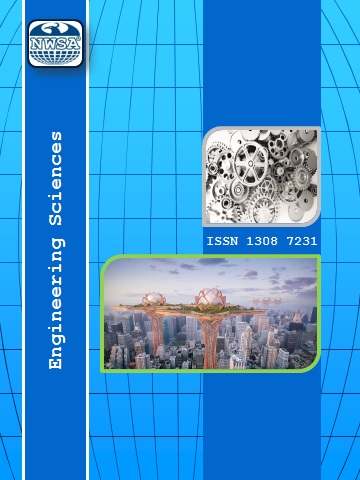References
[1] Kanna, A.G. and Parthasarathi, N., (2024). Experimental investigation on concrete by partial replacement of fine aggregate with olivine sand. In: Gencel, O., Balasubramanian, M., Palanisamy, T. (eds) Sustainable Innovations in Construction Management. ICC IDEA 2023. Lecture Notes in Civil Engineering, 388. Springer, Singapore. https://doi.org/10.1007/978-981-99-6233-4_6.
[2] MTA, Olivin. https://www.mta.gov.tr/v3.0/bilgi-merkezi/olivin. Bilgi merkezi, MTA Genel Müdürlü?ü.
[3] Altuncy, Y.T. ve Ceylan, H., (2023). Olivin agregaly harçlaryn yüksek sycaklyk etkisindeki mekanik davrany?lary. Uluslararasy Baty Karadeniz Mühendislik ve Fen Bilimleri Dergisi, 5(1):1-10. https://doi.org /10.55440/umufed.1190966.
[4] Turan, B. ve Acartürk, B., (2022). Olivin mineralinin seramik syrlarynda kullanym olanaklarynyn ara?tyrylmasy ve uygulamalary, 22:1157-1167. doi: 10.35414/akufemubid.1102493.
[5] Akyildirim, H., (2019). Betonda gama y?yny kalkany olarak kullanylan olivin minerali. Arab J Geosci, 12:264. https://doi.org/10.1007/s12517-019-4425-x.
[6] Papayyanny, I., Papachrystoforou, M., Patsiou, V., and Petrohilou, V., (2013). Development of fire resistant shotcrete with olivine aggregates. International IABSE Conference, Rotterdam May 6-8, 2013 Assessment, Upgrading and Refurbishment of Infrastructures Congress Report, 114-115.
[7] Zedef, V. ve Döyen, A., (2001). Olivin: Türkiye'de tanynmayan çok amaçly kullanymy olan bir hammadde ve ülkemiz olivin potansiyeline bir örnek: Kyzylda? (Akseki-Antalya) Olivin Yata?y. 4. Endüstriyel Hammaddeler Sempozyumu, Konya, 299-303.
[8] TS 25, (2008). Do?al puzolan (tras)-çimento ve betonda kullanylan- tarifler, gerekler ve uygunluk kriterleri. TSE, Ankara.
[9] TS EN 450, (2013). Uçucu kül-betonda kullanylan-bölüm 1: tarif, özellikler ve uygunluk kriterleri. TSE, Ankara.
[10] ASTM 618-12, (1994). Standard specification for coal fly ash and raw or calcined natural pozzolan for use in concrete, Annual book of ASTM standards, USA.
[11] Altuncy, Y.T. ve Ceylan, H., (2023). Olivin atyk tozunun puzolanik özelli?inin ara?tyrylmasy. Süleyman Demirel Üniversitesi YEKARUM e-Dergi, 8(1):13-19.
[12] Sancak, E. ve Çoban, Ö., (2014). Olivin atyklarynyn betonda kullanymynyn betonarme donatysynyn korozyon özelliklerine etkisi. Selçuk Üniversitesi Mühendislik, Bilim ve Teknoloji Dergisi, 2(4):26-41.
[13] Achang, M. and Radonjic, M., (2021). Adding olivine micro particles to Portland cement based wellbore cement slurry as a sacrificial material: A quest for the solution in mitigating corrosion of wellbore cement, Cement and Concrete Composites, 121. https://doi.org/10.1016/j.cemconcomp.2021.104078.
[14] Yavuz, D. ve Yazycy, ?., (2022). 2. Yangyn ve Yüksek Sycakly?yn Betonarme Yapylar Üzerindeki Etkisi. Uluslararasy Katylymly Yangyn Sempozyumu. Yzmir, 149-153.
[15] Ekinci, C.E., (2023). Bordo Kitap: Mimar ve Mühendisin Yn?aat El Kitaby. Ankara: Daya Yayynlary.
[16] Yüksel, Y., Siddique, R., and Özkan Ö., (2011). Infuence of high temperature on the properties of concretes made with industrial by-products as fne aggregate replacement. Constr Build Mater, 25:967972.
[17] Kyzylkanat, A.B. ve Yüzer, N., (2008). Yüksek sycaklyk etkisindeki harcyn basynç dayanymy-renk de?i?imi ili?kisi. YMO Teknik Dergi, 4381-4392.
[18] Short, N.R., Purkiss, J.A., and Guise, S.E., (2001).Assessment of fire damaged concrete using colour image analysis, Construction and Building Materials, 15(1):9-15. https://doi.org/10.1016/S0950-0618(00)00065-9.
[19] Khoury, G.A., (2000). Effect of fire on concrete and concrete structures. Progress in Structural Engineering and Materials, 2(4):429-447.
[20] Uysal, A., (2004). Yüksek sycakly?yn beton üzerindeki etkileri. Ystanbul Teknik Üniversitesi, Fen Bilimleri Enstitüsü, Yüksek Lisans Tezi, Ystanbul.
[21] Güçlüer, K., Yaldyz, M.R. ve Günaydyn, O, (2023). An Investigation of the High-Temperature Behavior of Basalt, Olivine, and Pyrophyllite Additive Mortars. Iranian Journal of Science and Technology, Transactions of Civil Engineering, 47:14671484. https://doi.org/10.1007/s40996-022-00996-6.
[22] TS EN 13501-1, (2019). Yapy ürünleri ve yapy elemanlarynyn yangyn synyflandyrmasy - Bölüm 1: Yangyna tepki testlerinden elde edilen veriler kullanylarak synyflandyrma. TSE, Ankara.
[23] ISO 834, (2014). Yangyna dayanyklylyk testleri Bina in?aatynyn elemanlary Bölüm 11: Yapysal çelik elemanlaryn yangyndan korunma de?erlendirmesine ili?kin özel gereklilikler.
[24] Durmu?, G. ve Can, Ö. (2009). Yüksek sycaklyk uygulanmy? katkyly betonun bulanyk mantyk ve regresyon yöntemiyle basynç dayanymyn tahmini. Politeknik Dergisi, 12(3):195-200.
[25] Thomas, C., Rico, J., Tamayo, P., Ballester, F., Setién, J., and Polanco, A., (2019). Effect of elevated temperature on the mechanical properties and microstructure of heavy-weight magnetite concrete with steel fibers. Cement and Concrete Composites, 103:80-88. https://doi.org/10.1016/j.cemconcomp.2019.04.029.
[26] Sarydemir, M. and Yyldyrym, A., (2022). Effect of elevated temperatures on properties of high strength mortars containing ground calcined diatomite with limestone sand. Journal of Building Engineering, 56. https://doi.org/10.1016/j.jobe.2022.104748.
[27] Husem, M., (2006). The effects of high temperature on compressive and flexural strengths of ordinary and high-performance concrete. Fire Safety Journal, 41(2):155-163. https://doi.org/10.1016/j.firesaf.2005.12.002.
[28] TS EN 197-1, (2012). Çimento - Bölüm 1: Genel çimentolar - Bile?im, özellikler ve kapsamly kriterler. TSE, Ankara.
[29] TS EN 933-1, (2012). Agregalaryn geometrik özellikleri için deneyler bölüm 1: Tanenin genel tarihsel tayini- Eleme yöntemi. TSE, Ankara.
[30] TS EN 1008, (2003). Beton-Karma suyu-Numune alma. TSE, Ankara.
[31] TS EN 12390-2, (2019). Beton - Sertle?mi? beton deneyleri - Bölüm 2: Dayanym deneylerinde kullanylan deney numunelerinin hazyrlanmasy ve küre tabi tutulmasy. TSE, Ankara.
[32] TS EN 12390-7, (2010). Beton - Sertle?mi? Beton Deneyleri - Bölüm 7: Sertle?mi? Beton Yo?unlu?unun Tayini. TSE, Ankara.
[33] TS EN 12390-3, (2010). Beton - Sertle?mi? Beton Deneyleri - Bölüm 3: Deney Numunelerinin Basynç Dayanymynyn Tayini. TSE, Ankara.
[34] Abdülkadir, G., (2024). Farkly su/çimento oranlaryna sahip kalsiyum alüminat çimentolu betonlaryn yüksek sycaklykta basynç dayanymlarynyn ve elastisite modüllerinin incelenmesi. Fen Bilimleri Enstitüsü Dergisi, 7(1):1-12.
[35] Chan, S.Y.N., Peng, G.F., and Chan, J.K.W., (1996). Comparison between high strength concrete and normal strength concrete subjected to high temperature. Mat. Struct. 29:616-619. https://doi.org/10.1007/BF02485969.
[36] Carlos, C. and Durrani, A.J., (1990). Effect of transient high temperture on high-strength concrete(Article). ACI Materials JournalVolume 87, Issue 1, January 1990, 47-53.
[37] Ma, O., Guo,R., Zhao,Z., Lin, Z., and He, K., (2015). Mechanical properties of concrete at high temperature-A review,Construction and Building Materials, 93:371-383. https://doi.org/10.1016/j.conbuildmat.2015.05.131.
[38] Popovics, S. and Ujhelyi, J., (2008). Contribution to the concrete strength versus water-cement ratio relationship. Journal of Materials in Civil Engineering, 20(7):459-463.
[39] Ercen, E., Özpynar, Y. ve Arslan, Y., (2014). Olivin agrega kullanylarak ysyya dayanykly beton üretimi, 67. Türkiye Jeoloji Kurultayy, Nisan, Türkiye.
 +90(535) 849 84 68
+90(535) 849 84 68 nwsa.akademi@hotmail.com
nwsa.akademi@hotmail.com Fırat Akademi Samsun-Türkiye
Fırat Akademi Samsun-Türkiye
